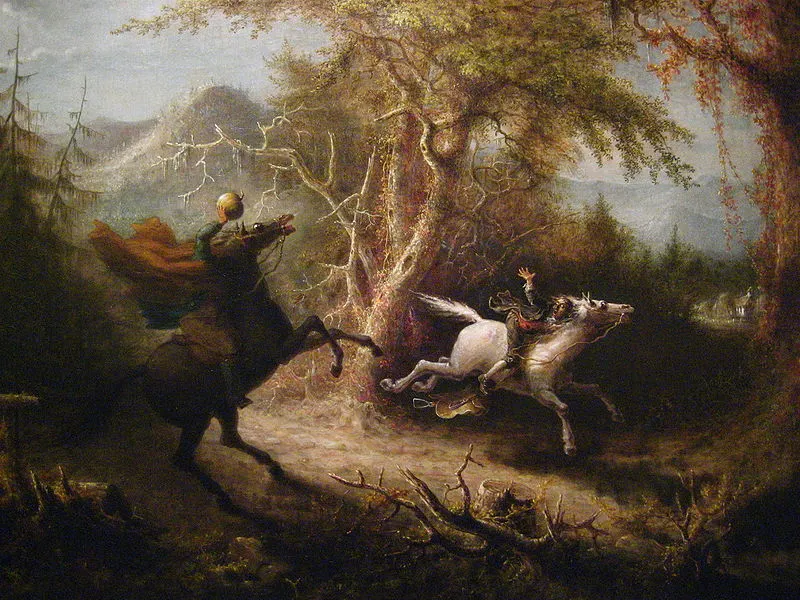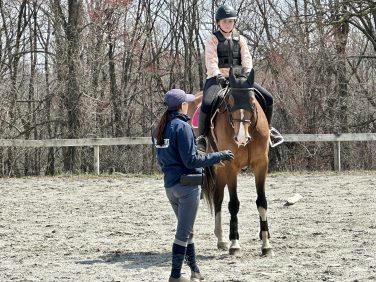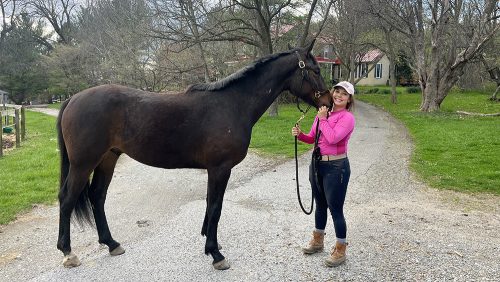It was a dark and stormy afternoon at The Chronicle office. Lightning flickered outside as gunpowder gray thunderclouds rolled and boiled over the Blue Ridge Mountains toward Middleburg. Fall is my favorite time of year in Virginia, and the bright assortment of colored leaves against the darkening sky created a striking backdrop on my drive home from another day buried in the tombs of equine history.
With Halloween just around the corner, I spent my week looking up different horsey tales of fright and foolery, but one clearly stood out above the rest. Who could forget the fabulous “The Legend of Sleepy Hollow” by Washington Irving, and the utterly creepy fiend, the Headless Horseman?
Many of you are probably familiar with the legend, but for those that may not have heard the tale, here is a link to the ghost story that may have inspired Irving: A New York Ghost Story.
Irving’s story has easily become one of the iconic American Halloween tales, and we love it not only for its spooky theme and dark humor, but also because the story is centered on real people and places in our history.
The tale takes place along the Tappan Zee River in Tarrytown and Sleepy Hollow, N.Y., roughly 25 miles north of Times Square in New York City in 1790.
Ichabod Crane, a lanky, intelligent school teacher, decided he wanted to marry Katrina Van Tassal, the daughter of the wealthy farmer, Baltus Van Tassel. Of course, Crane has an opponent in Abraham “Brom Bones” Van Brunt who is Crane’s polar opposite in the traditional “brawn vs. brains” competition.
Crane was pursued by the Headless Horseman after leaving a party at the Van Tassal house one night. He was chased through the countryside and just before he reached safety, the Horseman threw his head at Crane. Crane fell off his horse and was never seen again, adding to the mystery of the legend. The villagers of Sleepy Hollow searched long and hard for Crane, but they only ever found his trusty steed, Gunpowder, who returned to the stables on his own, a shattered pumpkin and Crane’s hat.
So who was the Headless Horseman and why did he pursue Crane? In the beginning of the story, Irving writes that the Horseman is a Hessian soldier who had his head severed by an American cannonball. The British hired Hessian soldiers during the Revolutionary War, and many were killed during the nearby Battle of White Plains. Irving said that this particular soldier was of unknown rank and buried near Sleepy Hollow.
ADVERTISEMENT
Who is ever and anon seen by the country folk hurrying along in the gloom of night, as if on the wings of the wind. His haunts are not confined to the valley, but extend at times to the adjacent roads, and especially to the vicinity of a church at no great distance … the ghost rides forth to the scene of battle in nightly quest of his head; and that the rushing speed with which he sometimes passes along the Hollow, like a midnight blast, is owing to his being belated, and in a hurry to get back to the church-yard before daybreak.
However, the end of the story suggests that the Horseman was actually Bones in disguise:
Brom Bones too, who shortly after his rival’s disappearance conducted the blooming Katrina in triumph to the altar, was observed to look exceedingly knowing whenever the story of Ichabod was related, and always burst into a hearty laugh at the mention of the pumpkin; which led some to suspect that he knew more about the matter than he chose to tell.
Regardless of this particular Headless Horseman’s identity, he’s become an American legend since Irving penned the tale. But Irving’s Horseman isn’t the only horseman in history with no head. Texas has its own horseman called El Muerto.
In the 1800s, Texas was still quite the wild and rowdy frontier, and in 1850 a man named Vidal was rustling cattle all over southern Texas. Soon enough he was wanted, dead or alive. Vidal and his henchmen had stolen a group of prized mustangs from Texas Ranger Creed Taylor. Taylor and his neighbor, Big Foot Wallace, quickly went after Vidal. They found the bandits unaware and killed the thieves, but they wanted to set an example.
Wallace beheaded Vidal and tied him firmly upright into the saddle on the back of one of the wild mustangs. He tied his head and sombrero to the saddle and set the horse loose. After a while, stories began to circulate about the headless rider in the countryside, and cowboys began shooting at the odd figure because they didn’t know what it was. Over time, the area became a place to avoid.
Finally, the mustang was captured, and they discovered that Vidal was still tied on his back, though he was full of bullets and arrows. The men who captured the horse buried the body and released the horse.
Of course, that should have been the end of the legend, but to this day travelers and ranchers swear they’ve seen the headless rider galloping across the plains.
ADVERTISEMENT
Yet another headless horseman story comes to us from Ireland in the form of the dullahan. Dullahans are headless, and they carry their craniums with them, either in their right hands or on the saddles of their horses. The heads are described as: “the color and texture of stale dough or moldy cheese, and quite smooth. A hideous, idiotic grin splits the face from ear to ear, and the eyes, which are small and black, dart about like malignant flies. The entire head glows with the phosphorescence of decaying matter and the creature may use it as a lantern to guide its way along the darkened laneways of the Irish countryside.”
The dullahan has supernatural sight and can see long distances by lifting his head up. The legend says that wherever a dullahan stops, a mortal person dies. He is mounted on a black horse that shoots sparks and flames from his nostrils as it runs. In some parts of the country, the dullahan drives a black coach driven by six black horses.
It’s hard to say where the legend of the dullahan came from—the fairy creature may have its roots in the Celtic god, Crom Dubh, a fertility god. Crom Dubh demanded human lives as a sacrifice, and his favored method was decapitation. When Christian missionaries came from Scotland in the sixth century, they denounced worship of such gods, and Crom Dubh began to transition into the dullahan.
England also has a headless horseman tale in the Arthurian legend, Sir Gawain and the Green Knight.
I’ve always wanted to trick or treat as the headless horseman, but I don’t think my neighbors would have appreciated me galloping wildly up to their houses and throwing pumpkins at their door instead of knocking. Still, “The Legend of Sleepy Hollow” will remain one my favorite scary horse stories. What’s yours?
One of web writer Coree Reuter’s favorite parts of working at The Chronicle of the Horse is adventuring up into the attic. While it’s occasionally a journey that requires a head lamp, GPS unit and dust mask, nearly 75 years of the equine industry is documented in the old issues and photographs that live above the offices, and Coree is determined to unearth the great stories of the past. Inspired by the saying: “History was written on the back of a horse,” she hopes to demystify the legends, find new ones and honor the horses who have changed the scope of everyday life with this blog.
Curious about anything in particular? Have a question or an interesting topic? Please e-mail Coree, she’d love to hear from you!















